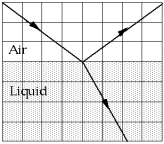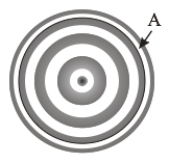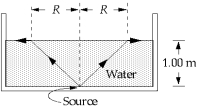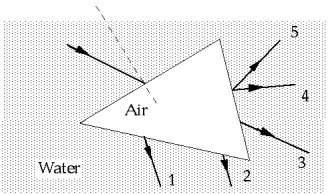A) 1 eV.
B) 2 eV.
C) 3 eV.
D) 4 eV.
E) 5 eV.
G) C) and D)
Correct Answer

verified
Correct Answer
verified
Multiple Choice
When the slits in Young's experiment are moved closer together, the fringes
A) remain unchanged.
B) move closer together.
C) move further apart.
D) are less intense.
E) are none of the above.
G) B) and C)
Correct Answer

verified
Correct Answer
verified
Multiple Choice
A light wave traveling in air impinges on an amber plate at an angle of incidence of 60º. If the angle of refraction is 34º, the velocity of light in amber must be approximately
A) 0.52 × 108 m/s.
B) 4.64 × 108 m/s.
C) 1.86 × 103 m/s.
D) 2.09 × 108 m/s.
E) 4.64 × 1010 m/s.
G) A) and E)
Correct Answer

verified
Correct Answer
verified
Multiple Choice
 A ray of light is shown reflected and refracted at the surface of a liquid. From the diagram you can determine that the speed of light in this liquid is approximately
A ray of light is shown reflected and refracted at the surface of a liquid. From the diagram you can determine that the speed of light in this liquid is approximately
A) 1.83 × 108 m/s.
B) 2.24 × 108 m/s.
C) 3.00 × 108 m/s.
D) 4.02 × 108 m/s.
E) 2.50 × 108 m/s.
G) All of the above
Correct Answer

verified
Correct Answer
verified
Multiple Choice
 The interference pattern is from a spherical lens placed on a flat reflecting surface using a monochromatic light of wavelength λ = 550 nm. If the distance from the center to A is 0.6 mm, the radius of curvature of the lens is
The interference pattern is from a spherical lens placed on a flat reflecting surface using a monochromatic light of wavelength λ = 550 nm. If the distance from the center to A is 0.6 mm, the radius of curvature of the lens is
A) 41.3 cm.
B) 82.5 cm.
C) 18.7 cm.
D) 37.4 cm.
E) 26.2 cm.
G) A) and B)
Correct Answer

verified
Correct Answer
verified
Multiple Choice
 Two polarizing films are crossed with their transmission axes making an angle of θ = 20° with each other. The vectors that represent the plane-polarized wave train passed by the second polarizing film are
Two polarizing films are crossed with their transmission axes making an angle of θ = 20° with each other. The vectors that represent the plane-polarized wave train passed by the second polarizing film are
A) 1 - 1'.
B) 2 - 2'.
C) 3 - 3'.
D) 4 - 4'.
E) None of these is correct because no light passes through the second disk.
G) All of the above
Correct Answer

verified
Correct Answer
verified
Multiple Choice
Two side-by-side coherent light sources radiate at 480 nm. At a point in space where the path difference to these two sources is 50 nm, the phase difference could be
A) 0.238 radians.
B) 0.375 radians.
C) 0.466 radians.
D) 0.582 radians.
E) 0.654 radians.
G) A) and B)
Correct Answer

verified
Correct Answer
verified
Multiple Choice
 You place a point source of light at the bottom of a pool of water 1.00 m deep. The source emits rays upward in all directions. You notice that a circle of light is formed by the rays that are refracted into the air and that the rays outside of this circle are reflected back into the water. The index of refraction of water is 1.33. The radius R of the circle at the surface of the water is approximately
You place a point source of light at the bottom of a pool of water 1.00 m deep. The source emits rays upward in all directions. You notice that a circle of light is formed by the rays that are refracted into the air and that the rays outside of this circle are reflected back into the water. The index of refraction of water is 1.33. The radius R of the circle at the surface of the water is approximately
A) 0.75 m.
B) 1.00 m.
C) 1.13 m.
D) 1.33 m.
E) infinite.
G) D) and E)
Correct Answer

verified
Correct Answer
verified
Multiple Choice
 An air prism is immersed in water. A ray of monochromatic light strikes one face as shown. The emerging ray is
An air prism is immersed in water. A ray of monochromatic light strikes one face as shown. The emerging ray is
A) 1.
B) 2.
C) 3.
D) 4.
E) 5.
G) A) and C)
Correct Answer

verified
Correct Answer
verified
Multiple Choice
Diffraction of sound waves is more readily observable than that of light waves because
A) sound waves are longitudinal and not transverse.
B) sound waves have a higher frequency than light waves.
C) sound waves have a lower velocity than light waves.
D) sound waves have longer wavelengths than do light waves.
E) interference occurs more readily for longitudinal waves.
G) A) and C)
Correct Answer

verified
Correct Answer
verified
Multiple Choice
The index of refraction of a sample of glass cannot be determined by measuring the
A) Brewster's angle.
B) critical angle.
C) angle of minimum deviation.
D) ratio of true to apparent depth.
E) angle of dispersion between red and violet light.
G) A) and D)
Correct Answer

verified
Correct Answer
verified
Multiple Choice
The wavelength of light that has a photon energy of 4.25 eV is
A) 292 nm.
B) 973 nm.
C) 706 nm.
D) 1559 nm.
E) None of these is correct.
G) A) and D)
Correct Answer

verified
Correct Answer
verified
Multiple Choice
Laser light passes through a circular aperture. If the brightness of the light is increased, the width of the central dark fringe will
A) increase.
B) decrease.
C) oscillate.
D) remain unchanged.
E) There is not enough information to determine what will happen.
G) B) and D)
Correct Answer

verified
Correct Answer
verified
Multiple Choice
A ray of light passes from air into water, striking the surface of the water with an angle of incidence of 45º. Which of the following four quantities change as the light enters the water: 1) wavelength, 2) frequency, 3) speed of propagation, and 4) direction of propagation?
A) 1 and 2 only
B) 2, 3, and 4 only
C) 1, 3, and 4 only
D) 3 and 4 only
E) 1, 2, 3, and 4
G) A) and C)
Correct Answer

verified
Correct Answer
verified
Multiple Choice
The minimum angle of deviation produced by a glass prism n = 1.70 for the light used) whose apex angle is 45º is approximately
A) 32º.
B) 36º.
C) 26º.
D) 18º.
E) 45º.
G) B) and E)
Correct Answer

verified
Correct Answer
verified
Multiple Choice
Two polarizers have their transmission axes at an angle θ. Unpolarized light of intensity I is incident on the first polarizer. What is the intensity of the light transmitted by the second polarizer?
A) I cos2 θ
B) 0.5I cos2 θ
C) 0.25I cos2 θ
D) I cos θ
E) 0.25I cos θ
G) None of the above
Correct Answer

verified
Correct Answer
verified
Multiple Choice
In dealing with the diffraction pattern of a single slit, we are usually interested in the location of the first minimum in light intensity because
A) it is the only one that can be determined accurately.
B) it is the only one for which the small-angle approximation holds.
C) nearly all the light energy is contained in the central maximum.
D) it is the only one for which the location is directly proportional to the wavelength of the light.
E) it is the only one that can be described by Fraunhofer diffraction.
G) B) and D)
Correct Answer

verified
Correct Answer
verified
Multiple Choice
The eyes of a person with normal vision have an angular resolution of 1/60) o. For a person who cannot resolve as many details on an eye chart as a person with normal vision, that angle will
A) increase.
B) decrease.
C) remain unchanged.
D) change, but whether it increases or decreases depends on if the person is nearsighted or farsighted.
E) There is not enough information to determine what will happen.
G) A) and C)
Correct Answer

verified
Correct Answer
verified
Multiple Choice
 The interference and diffraction envelopes of a double slit are shown separately but to the same scale in the figure. For this arrangement, the number of fringes in the second diffraction maximum is
The interference and diffraction envelopes of a double slit are shown separately but to the same scale in the figure. For this arrangement, the number of fringes in the second diffraction maximum is
A) 3.
B) 4.
C) 5.
D) 7.
E) 0.
G) D) and E)
Correct Answer

verified
Correct Answer
verified
Multiple Choice
A 60° prism has a refractive index of 1.52. Calculate the angle of incidence for the initial light ray that is then refracted inside the prism and just undergoes total internal reflection at the opposite face of the prism.
A) 41.1°
B) 18.9°
C) 29.4°
D) 30.6°
E) 60.6°
G) A) and D)
Correct Answer

verified
Correct Answer
verified
Showing 101 - 120 of 182
Related Exams